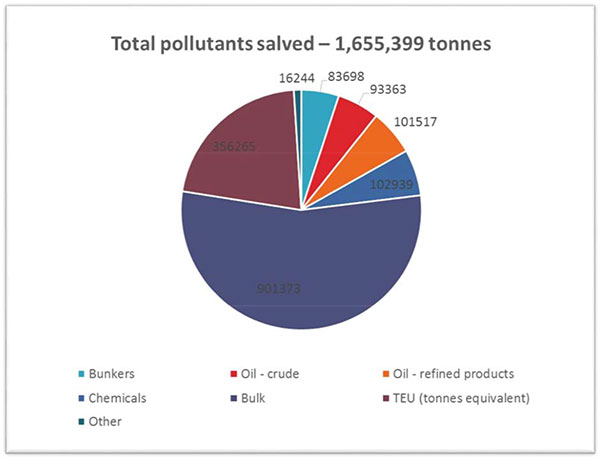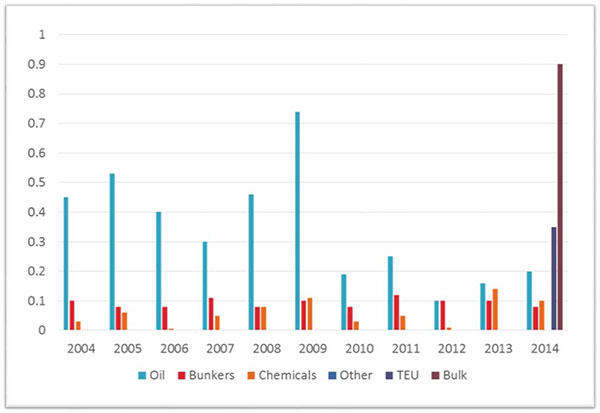Issued 25th March 2015
International Salvage Union members provided more than 200 services and made major contribution to environmental protection in 2014
Members of the International Salvage Union (ISU) provided 216 services to vessels carrying 1,655,399 tonnes of potentially polluting cargoes during operations in 2014 in a major demonstration of the value of their work towards protecting the marine environment.
President of the ISU, Leendert Muller, said: “Yet again our members are to be congratulated for the great benefit they have delivered in helping to protect the marine environment from potential damage. We represent a vital service to both the shipping industry and wider society. Shipping has generally become safer but everyone in the industry should be aware that just one major casualty could cause an environmental disaster.”
The numbers are published in the ISU’s 2014 Pollution Prevention Survey which has been re-based and so direct comparisons with previous years’ totals and some sub- categories are not appropriate. The 2013 version of the survey showed ISU members salved 718,000 tonnes of potential pollutants in 190 services.
2014 ISU Pollution Prevention Survey Results (tonnes)
| 2014 | 2013 | |
| Number of services | 216 | 190 |
| Bunker fuel | 83,698 | 106,146 |
| Oil cargo | 194,880 | 165,395 |
| Chemicals | 102,939 | 147,987 |
| Bulk polluting/hazardous | 901,373 | N/A |
| TEU (tonnes equivalent) | 356,265 (23,751TEU @ 15 tonnes/TEU) | |
| Other pollutants | 16,244 | 299,074 |
| Totals | 1,655,399 | 718,602 |
*Note: changed survey methodology for 2014 invalidates direct comparison of totals and some sub-categories
Commenting further on the results, Mr Muller said: “For some while ISU has been concerned that its annual pollution survey should be updated. The survey started in
1994 – an era when the threat, and fear, of pollution was driven by disasters associated with VLCCs. That threat still exists but coastal states – and society as a whole – now consider most cargo to be potentially polluting. Since the survey began, containerised cargo has grown hugely in both total volumes and the capacity of boxships. Containers, with their mixed and sometimes hazardous contents, are undoubtedly a potential pollutant and it is right that our survey should start to record them as such.
“ISU is careful to point out that not all of the salved cargo noted in the survey was at imminent risk of going into the sea. But even with a relatively simple rescue tow it is worth considering what the consequences might be if there was no commercial provision of salvage services.”
The new format of the survey records separately for the first time dirty or hazardous bulk cargo and containers (by tonnes equivalent). It follows debate at the 2014 ISU AGM at which members considered the best way to present their pollution prevention efforts and takes account of the International Convention on the Prevention of Pollution from Ships (MARPOL), the International Maritime Dangerous Goods Code (IMDG Code), Intercargo guidance, P&I Club guidance; International Tanker Owners Pollution Federation publications and the International Solid Bulk Cargoes Code. The attitude of coastal state authorities has also been considered based on ISU members’ operational experience.
The figures for 2014 therefore represent a modified survey and will create a new baseline against which future years may be compared.
In 2014 ISU members provided 216 services. Variants of wreck removal contracts were used in 61 services; Lloyd’s Open Form – 29 services (44 in 2013); towage contracts – 29 services; Japanese Form – 19 services; Fixed Price – 4 services; Day Rate – 12 services; other contracts – 32 services.
In the period 1994 to end-2013, ISU members salved 18,575,702 tonnes of potential pollutants, an average of just under one million tonnes per year. This consists of 13,142,007 tonnes of oil cargoes; 1,307,706 tonnes of chemicals; 1,616,101 tonnes of bunker fuel and 2,818,565 tonnes of “other pollutants”.

Trends, millions of tonnes

[Note: changed methodology for 2014 survey means direct comparisons of some categories is not appropriate.]